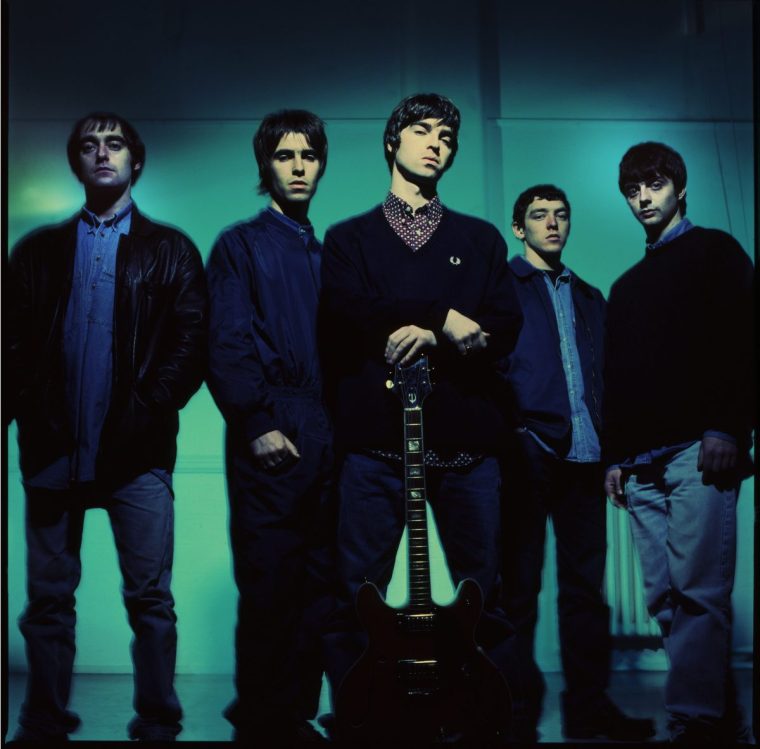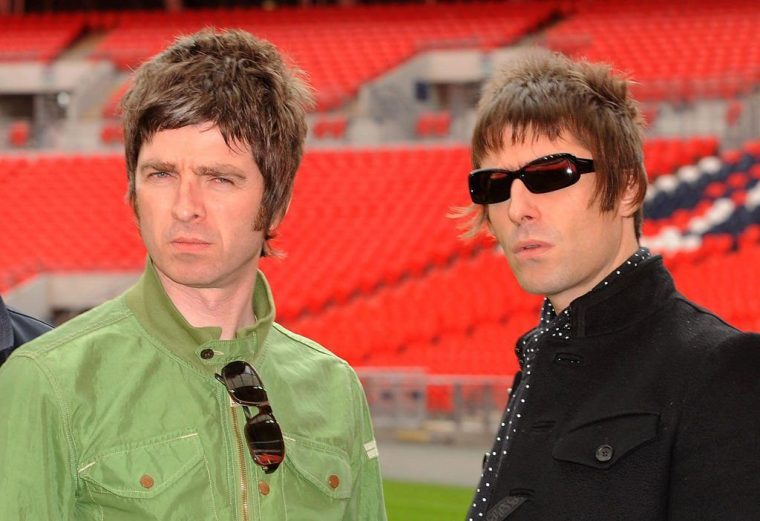Are the Gallagher brothers misunderstood? It’s a question that even Noel and Liam, with their straight-talking aversion to navel-gazing, might guffaw at. But two new books make a compelling case that long-held perceptions of the brothers might need to be refreshed.
The books take different approaches. Taking their solo careers as a starting point, Gallagher, written by PJ Harrison, a teenage fan turned colleague and friend of the band, takes a meticulous, deeply personal look at the brothers: their background and character; their relationship and those with others, particularly the women in their lives (the word “Blur” is mentioned just once in a passing reference to Alex James).
By contrast, Live Forever, by musician and journalist John Robb, a Gallagher friend since the late 80s, takes an excitable, painstakingly researched and greatly detailed dive into their career, through pre-formation to their life-changing Britpop triumphs and beyond, complete with exhaustive analysis of Oasis’ catalogue.
What connects both books, alongside a passion for the music and putting the Oasis phenomenon in a social context – a “northern working-class revolution” as Robb puts it – is that the Gallaghers are due an artistic and personal reassessment. From the outset, Harrison claims: “The public image of them remains hard boiled in the lager-drinking, not-for-victory-V-sign-waving mould of 90s tabloid headlines. Their artistic evaluations remain lazy, built on the back of early mentions of T Rex and the Beatles.”
It is a theme that runs through Robb’s book, too: he rails several times against the “2D” press caricature of the Gallaghers that “quickly reduced them to 2D stereotypes… cardboard cut-outs of drugs, scraps, scrapes and outrageous quotes creating a simplistic version of the complex characters they were in real life.” For Robb, “Liam’s innate understanding of how to sing Noel’s songs” is a truer reflection of their bond than any number of punches thrown.

But the Gallaghers’ reputation is rooted in truth. As Robb notes, they needed little encouragement to play up to it. The fights were numerous and all too real: Robb was himself witness to one of the most infamous, at Rockfield studios in Monmouthshire during the recording of (What’s the Story) Morning Glory? that involved Noel attacking Liam with a cricket bat. The fight that split Oasis in Paris in August 2009, covered in delicious detail by Harrison, was frenzied and violent: Liam did, in the words of Noel, wield a guitar like an axe. The mouthing off, the bravado, the toxic masculinity, the excessive drink and drugs – it was all there, part of a combustible cocktail that initially made Oasis’s primal rock ’n’ roll so exciting.
But Harrison in particular goes further than most in getting to the core of who the Gallaghers are. The Gallaghers grew up poor on a council estate in Burnage, Manchester, to Irish immigrant parents. Their father, Tommy, was a violent drunk who terrorised his family: Noel, older brother Paul and mother Peggy bore the brunt with regular beatings (Noel developed a childhood stammer that required speech therapy to overcome) that Liam, the youngest, escaped. Peggy took the children and left her husband in 1976, but by then theirs was a life built on a “foundation of trauma and resilience”. It had lasting consequences, forging patterns of behaviour and personality traits – as well as a brotherly bond – that continued into adulthood.
Young Noel withdrew to his bedroom and the sanctuary of his guitar and records; he became “guarded and fiercely independent, developing a thick skin and a sharp tongue as defence mechanisms”. Harrison paints Noel as someone who can be emotionally distant, seeking control, putting a high value on loyalty and happy to ostracise people who break his trust (as treatment of former Oasis drummer Tony McCarroll, his ex-wives Meg Matthews and Sara MacDonald, and, until recently, Liam, attests).
Liam, on the other hand, was the typical “rebellious child”, shut out of the bond of trauma shared by Noel and Peggy, impulsive, unpredictable, longing for attention; he was both scarred by and drawn to the violence he witnessed. “He craves mayhem and disorder, and when it doesn’t exist, he will create it” – behaviour that was both encouraged and greatly rewarded by the music industry, stunting emotional growth. Ways of survival, of seeing and interacting with the world, were forged in the “battleground” of their childhood home: Noel needing the safety of control, Liam seeking the danger of disruption; one needing authority, the other seeking to challenge it. In short: “Noel compartmentalises pain, while Liam externalises it.”

Harrison makes the salient point that “media portrayals of these two men are almost always lacking in empathy when it comes to this aspect”. It’s surprising that in an era with greater understanding of trauma and mental health issues – something increasingly mined by artists in both song and PR narratives – it is still a seldom interrogated part of the Gallagher story. This is admittedly in part due to the brothers’ own refusal to trade on it – that Northern male stoicism in action. In fact, the brothers, Noel in particular, have often gone to great lengths to play it down, instead talking up Peggy’s heroism and contextualising it as a normal upbringing in 70s Manchester, even accentuating positives (“My dad beat the talent into me,” Noel said in 2016). As Robb notes, “they never really talked about it or wallowed in it.”
So little regard was given to the brothers’ past pain that in 1996 the News of the World surprised the Gallaghers by arranging for the estranged Tommy to go backstage at an Oasis gig in Dublin, hoping for an explosive family reunion. It was an unimaginably cruel and unforgivably wretched act. While Liam reacted in anger and had to be restrained – “the fight he longed to have as a child but never could,” as Harrison puts it – the situation was diffused by Noel, who took Liam back to their hotel. It was, as Robb writes, “a moment of emotional turmoil”, but one that Harrison notes perfectly sums up the brothers contrasting characters.
Their childhood pain certainly helps explain, if not excuse, some of their poor and aggressive behaviour over the years (something Harrison doesn’t shy away from). But that pain also drove their ambition and desire to escape. And as Robb writes, you can hear it in the music. “You can feel the traumatic upbringing played out in their music a few years later with Noel’s claustrophobic sounding yet anthemic early anthems… you could hear it in the barely concealed anger in Liam’s voice… scarred by the emotional angst of a tempestuous youth soundtracking the internal anger… both brothers soundtracked universal emotions sparked by their painful family life.”

Their experiences shaped how they behaved in the context of Oasis: Noel quickly took control of the band that he was the last to join; Liam’s rock ’n’ roll image, Harrison argues, is “a deceptively complex mix of bravado, vulnerability and defiance… a carefully constructed parka-shaped armour that allows the core aspects of his inherent personality to be amplified in a manner that protects the private self”. But if the music initially benefitted from the Gallagher yin and yang, the warp speed fame, success and money – on a previously unseen scale for an independent band – exacerbated existing issues and amplified differences. Ironically, it also bound the brothers together in a way they would never be able to outrun. “Without the band they would have drifted away from each other much, much earlier,” Harrison writes.
And so Noel became “more withdrawn and controlling”, Liam “erratic and unpredictable”. A power struggle came to the boil (and never stopped simmering) during the making of Morning Glory. “It’s not a power struggle in the usual sense,” Harrison writes, “it’s a need for chaos versus a need for order. The brothers’ rivalry is rarefied oxygen and it’s zero-sum. What feeds one starves the other.”
The split is described in both books as inevitable and a long time coming, the natural end point of years of unresolved anger and resentment. Harrison does a fine job of dissecting the solo years: the unexpected up-off-the-canvas success for Liam with number one albums and huge ticket sales; Noel’s flourish of artistic experimentation in albums like 2017’s excellent Who Built The Moon?. Robb, for his part, argues gamely that Oasis’s 21st-century albums, particularly the psych-flavoured 2008 swansong Dig Out Your Soul, show a “sonic evolution” far beyond their reputation for musical conservatism that their detractors seem unable, or unwilling, to shake.

Harrison’s exploration of how the Gallaghers reacted to the split and co-existed apart – through affairs and divorces, family feuds and legal disputes – make for intriguing reading. Often defining themselves in opposition to one other, Liam nonetheless saw Noel’s splitting of Oasis as “a betrayal of the highest order,” a fraternal bond needlessly broken. The brotherly animosity and public war of words veer from childish to seriously ugly, reaching an unseemly nadir during a 2018 social media spat involving Liam, Noel’s then-wife Sara and Noel’s daughter Anais, the Gallagher hostility infecting wider family.
But in the years since, there has been a sea change behind the scenes, not least in Liam. On social media he still knowingly plays up to type, but Harrison describes a matured, focused man taking his health and career more seriously – a family man willing to apologise and mend bridges (not least with his erstwhile estranged daughter Molly). Liam has said as much, but Harrison credits Liam’s partner and manager Debbie Gwyther for reshaping his life and steering him towards smart decisions that have benefited his career and personal life. “It was a singular act of managerial coercion,” writes Harrison. “Debbie Gwyther: The Liam Whisperer.”
As Harrison writes, it has been enough for Noel to go against his nature and let Liam back into his life (that and a sackload of money, of course). But even if they are, as Harrison puts it, “reunited if not reconciled”, the fact a reunion is happening at all shows outmoded opinions of music’s most famous siblings could be just that. They are older and by all accounts wiser. What happens this summer will be fascinating.
